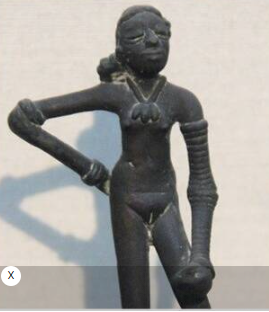ForumIAS announcing GS Foundation Program for UPSC CSE 2025-26 from 19 April. Click Here for more information.
ForumIAS Answer Writing Focus Group (AWFG) for Mains 2024 commencing from 24th June 2024. The Entrance Test for the program will be held on 28th April 2024 at 9 AM. To know more about the program visit: https://forumias.com/blog/awfg2024
Contents
Source: The post is based on the article “What Mohenjodaro’s Dancing Girl figurine tells us about the prehistoric civilisation” published in the Indian Express on 27th May 2023
What is the News?
Recently, the Prime Minister inaugurated International Museum Expo. The Mascot of the International Museum Expo is a contemporized version of the Mohenjodaro’s Dancing Girl made of wood in the Chennapatnam art style.
Note: The Mohenjodaro’s dancing girl is just 10.5 cm in height, is dark and completely in nude with the exception of multiple bangles and a necklace.
About the discovery of Mohenjodaro’s Dancing Girl

The Indus Civilisation (3300-1300 BC with its mature stage dated to 2600-1900 BC), is also known as the Harappa-Mohenjodaro Civilisation. After the initial recognition as an ancient civilisation, a series of excavations were conducted in the two major sites – Harappa and Mohenjodaro.
The Dancing Girl was discovered in one such excavation in Mohenjodaro in 1926, by British archaeologist Ernest McKay.
Even though Mohenjodaro and Harappa became part of Pakistani territory after the Partition, the Dancing Girl remained in India as part of an agreement. Today, the bronze figurine is at the National Museum of India.
What does the finding of Mohenjodaro’s dancing girl signify?
The very existence of a figurine such as the Dancing Girl, indicates the presence of high art in Harappan society. The degree of its sophistication indicates a society’s advancement.
The bronze statuette shows the degree of sophistication of Harappan artistry and metallurgy. The Dancing Girl is evidence of the civilisation’s knowledge of metal blending and lost-wax casting – a complicated process by which a duplicate sculpture is cast from an original sculpture to create highly detailed metallic artefacts.
The Dancing Girl by all appearances is not an object built for some utilitarian purpose – artists took great time to create an artefact of purely symbolic, aesthetic value.
| Read more: Indus valley Civilization: Important aspects and new developments |
How historians described Mohenjodaro’s Dancing Girl?
Various historians described the dancing girl such as a) An air of lively pertness, quite unlike anything in the work of other ancient civilisations, b) A young girl, her hand on her hip in a half-impudent posture, and legs slightly forward as she beats time to the music with her legs and feet.




